
Vintage Pistols Home >> Range Reports >> Smith & Wesson 642 Range Report
Smith & Wesson Model 642-2 - .38 Special +P Revolver
In my opinion, this is one of the best carry guns ever made - but it is not for everyone. The Smith and Wesson 642 "Airweight" is an aluminum and stainless steel J-frame, 5-shot revolver chambered in .38 Special +P. I was surprised to see that the price for these went up by about $100 since I bought mine a few years back. I've owned this gun for a while and carried it a lot, so I figured I do a range report.
When I first saw and handled this gun, here are the thoughts that went through my mind (in order):
- Man! That's ugly!
- Wow! That grip is small; I can barely hold it.
- Holy cow! Those sights suck.
- The only thing worse than the sights is the trigger pull.
- Hmmm. It's light.
- I guess that .38 +P is a pretty potent caliber in such a small firearm.
- The laser grips are kinda cool.
- This thing is smooth; there's nothing on it that can snag.
- Well, it's a really good price....
Needless to say, I bought it. I haven't regretted it a bit. Here are some facts and my opinions about the 642 (it's up to you to determine which are facts and what is opinion):
|
Click on a picture for a larger image |
||
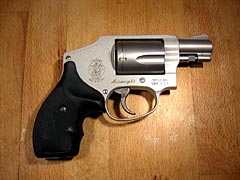 |
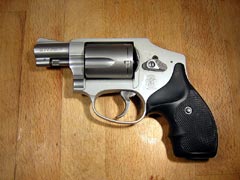
| 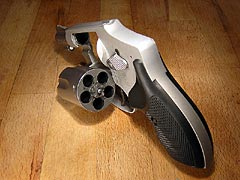
|
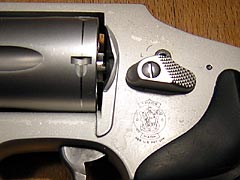
| 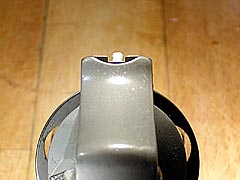
| 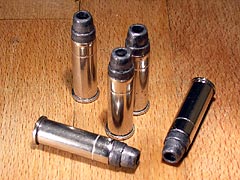
|
The 642 is an enclosed hammer, double action-only revolver with a 1-7/8" barrel. It features a small S&W round butt J-frame grip. The one I bought came with Crimson Trace laser grips (more on those later). I have the 642-2 model; I'm not sure what differentiates this from earlier models but I'm sure that you can look it up if you're curious. It has a smooth (non-grooved) trigger and a serrated ramp front sight. The rear sight consists of a slot cut into the top strap. I didn't know it when I bought it, but this is old-school Smith & Wesson. I've since bought an old M&P from the 40's and Regulation Police from the 20's with the same sight setup. They grow on you. These sights are pretty quick to acquire (once you're used to them), and they generally shoot to point-of-aim with the right load.
The 642 measures 6-1/2" long, 4-1/4" high, 1-5/16" thick, and weighs 17.6 ounces fully loaded with five 158gr LSWCHPs. Its frame is made from aluminum alloy. The cylinder, crane, and barrel (not a sleeve like some of the PD models - it's the whole barrel) are made from stainless steel. I have no idea why they picked this combination of materials, but I assume that the engineers at S&W have it all figured out by now. I've read that the 642 will loosen up with a steady diet of +P loads. However, I've put about 3000 rounds of +P down the pipe (along with a bunch of non +P .38s) and my gun is still tight as a drum. In my opinion, unless you'll be using it as a rental gun, you can run as much +P as you can stand and you won't detect any "loosening" at all. I think this is one of those printed-so-many-times-it-becomes-fact type of myths. If you have one of these, go ahead and "shoot it like you stole it" and not worry a bit.
The Trigger
Like I said, when I bought this, one of my first impressions was that the trigger sucked. Being a novice, I expected to correct this
simply by installing lighter springs. I was wrong. I installed reduced power hammer and rebound springs from Wolff Gun Springs.
The install is easy for the hammer spring, a bit more difficult for the rebound spring. I'm not going to explain how to do it here because I don't
recommend it. After I installed the lighter springs, I think the trigger felt better, but not much. For a while, reliability was good with the
new springs. Then one day, I was shooting in cold
(11°) temperatures when I had a couple of failure-to-fires. The revolver had been sitting exposed to the cold for an hour or so (long enough
to cool down) when it happened. It hasn't happened on factory ammo since. However, if I'm going to depend on this gun, "bang" is infinitely preferable
to "click" regardless of the temperature, so I put the stock springs back in it. You may live in a warmer climate - or live in a cold climate and
figure that the revolver won't get that cold because you'll be carrying it - but think about maybe leaving this in the car on a cold winter night, and then needing it.
I'm not taking any chances. Again, I'm giving the engineers at S&W the benefit of the doubt.
Over time, the trigger felt much better...
Here's the thing: I've put a bunch of rounds through mine, and I've dry-fired it probably 50,000 times. One of my friends recently bought a new 642 and we met up at the range. He had installed the lighter springs, and we were comparing trigger pulls. Mine felt MUCH lighter and smoother, and I had heavier springs installed. If you get one, try dry-firing it a few tens of thousands of times before you do anything to it and you'll probably get the trigger you want. I thought about getting a proper trigger job done on it, but by now I figure it's a fait accompli.
The Grips
I understand that grip choice is personal. What works for me will likely not work for you. Rather than make recommendations, I'll just
relate my experiences.
My 642 came with Crimson Trace laser grips. For a long time I used them, and tried to get used to them.
I found it hard to see the laser much beyond ten yards in the daytime, and in spite of what the literature said, the laser didn't necessarily turn on when I
took a natural grip - I found myself adjusting my grip to get the laser to turn on. When the battery died, I didn't replace it right away and found
that I was shooting better without the laser. I sold the laser grips and tried a variety of other types. I found the wooden and hard plastic
grips to be too slippery, so I tried some over-molded grips. They're the ones that have a hard plastic core with squishy rubber molded around them.
These felt the best and gave the best grip on the gun, but they were big and harder to conceal. The soft rubber also made the gun "sticky" when trying
to get it out of a pocket. I pocket carry a lot in the summer, and these grips would turn your pocket inside out on the draw. I finally settled on the
stock S&W rubber grips (which are Uncle Mike's Boot Grips). For me, these offer the best combination of concealability, ease of draw, and comfort while shooting.
The Finish
In terms of durability, do not mistake aluminum alloy for stainless steel. The frame of the 642 and other aluminum J-frames like the 637, 317, etc
are coated with a clear lacquer to protect the aluminum. If the lacquer is damaged or removed, the frame oxidizes quickly. My experience
has been that the lacquer is easily damaged through normal use and/or aggressive cleaning. If you look at the pictures above (especially the one on
the bottom left), you'll see that the lacquer on mine is discolored, wrinkled in places, and starting to flake off. I caused this by (stupidly)
letting it soak in Hoppes No. 9 overnight. Just carrying it can cause the lacquer to wear. If the gun is in contact with your skin, or gets
exposed to sweat - either directly or because your holster absorbs it - you will lose some of the finish. The Model 637 in the photo below belongs
to Tele_Mark from NortheastShooters.com. The lacquer wear, and the resulting dark grey areas were caused by sweat while carrying IWB.
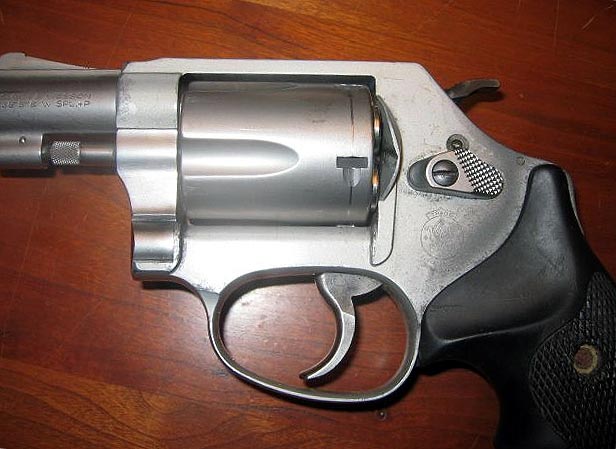
As long as you take care of the gun and keep it oiled, the lacquer loss and resulting oxidation is just a cosmetic issue. However, if you don't take care of an aluminum J-Frame with lacquer loss, the results can be very ugly. I was at a shop a while back and the guy had a Model 317 (8-shot .22LR snubbie) in the case for $150. The part of it that I could see looked pretty decent. Since these usually fetch 3 times what he was asking, I asked to take a look at it. He kind of laughed as he opened the case and handed me the revolver. It was nasty. The side that I couldn't see was loaded with 1/16" deep crusty white pits. Have you ever seen an aluminum boat railing that has white pits and crust all over it due to exposure to salt water? Well that's what this gun looked like. I wish I'd taken a picture of it. The owner explained that he got it from a guy that carried it in an ankle holster as a backup gun. The guy pretty much just left it in the holster all the time. After about a year, it was so badly oxidized that the cylinder (which is made of the same alloy as the frame on a 317) wouldn't even turn! If you're going to carry a 642, it's probably a good idea to take it out of it's holster every night and wipe it down.
Shooting the 642
With its tiny grip, long trigger pull, short sight radius, and stout recoil, the 642 is a hard gun to shoot well. It is not a good handgun for a beginner,
although I've seen several times where a gun shop employee will go out of his way to try to talk a newbie into one. When I bring this gun to the range,
nobody wants to shoot it. Occasionally someone will ask to try it if they're thinking of buying one; and more than once, that person has decided not to get
one after shooting mine. When I first tried it, I had a hard time hitting anything with it. If you don't like to practice, this is not the gun for you.
I've found that when most people shoot this for the first time, they grip it too low (as shown on the left below). A low grip makes the recoil feel worse and makes the gun it harder to control during the trigger pull. I found that I get the best results when I grip it as high as possible (as shown on the right).
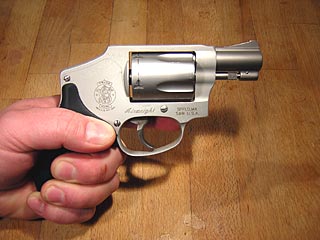 Wrong - Gripped too low |
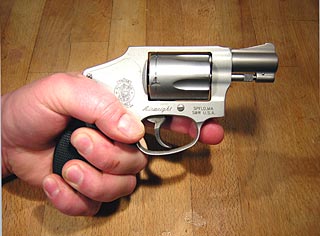 Right - Gripped high |
Look at the "wrong grip". With a low grip, the bore axis is well above your hand. Since you're hanging onto it with only your middle and ring fingers, the muzzle flips up under recoil. Also note where my index fingertip is in the picture - it barely reaches the front of the trigger guard. You end up pulling the trigger with the pad of your finger. This might be fine for a tricked out 1911, but this is a double action revolver with a long, relatively hard pull. Contrast that with the photo on the right. With a high grip, the meaty part of your hand backs up the gun much more, and you're gripping it closer to the bore axis. In addition, you can now use your thumb to help grip the gun. These factors make muzzle flip much easier to control. Your trigger finger now extends well in front of the trigger guard. This allows you to pull the trigger with the first joint of your finger. The increased leverage enables you to pull the trigger faster and minimizes movement of the gun when you do pull the trigger.
With 158 grain ammo, my gun consistently shoots about 3" high and 1" to the right of point-of-aim at 25'. From what I can gather by talking to other 642 owners, this is not typical - theirs shoot very close to point-of-aim. I thought about sending it back to S&W to see if they could correct it, but I've gotten used to it the way it is. It'll make little difference at the range at which this revolver is likely to be used.
Accuracy
There's a somewhat-common misconception that short barreled revolvers are not accurate. While this may be true for some of the cheap brands, the limiting
factor on the accuracy of a Smith & Wesson snubbie is not the short barrel, but rather the shooter's ability to repeat and hold a sight picture through the trigger pull.
I was present while a couple of people were shooting a used S&W Model 60 (stainless steel J-frame with a 1-7/8" barrel) in a Ransom Rest. Using
factory-loaded American Eagle ammo, they put 5 shots into a single ragged hole at 50 feet - every time. I watched an old-timer (I believe he was a retired
detective) pick off clay pigeons resting on a berm with a J-frame .38 at 75 yards. Once I realized how accurate these things could be, my shooting
actually improved.
When I first got this gun, I couldn't hit anything with it. I use paper plates for targets. The first time I took the 642 to the range, I was putting only two out of five on the plate at 7 yards. Now, after lots of practice (mostly dry firing), shooting offhand I'm now able to quickly put five shots into a 3" group at that distance. When I shoot this gun, I try not to "stage" the trigger; instead I concentrate on executing a smooth continuous pull. I found myself naturally getting faster as I practiced. For live fire practice, I use handloads with the same bullet weight and velocity as my carry ammo (I use 158gr lead round nose bullets for practice). Like anything worth doing, practice with a 642 is work. Nobody is going to describe the 642 as "a pleasure to shoot". I'm no recoil nancy, but after a couple hundred rounds of +P, my hand is going to be a bit sore.
Ammo
For carry ammo, I use +P 158 grain, lead semi-wadcutter hollowpoints from Remington (No. R38S12). Remington calls them "lead hollowpoints".
These are similar to the old "FBI Loads". Several manufacturers still make them, but Remington's version (shown in the picture above) has softer lead,
and a larger "hollow" in the hollowpoint. These expand OK at snubbie velocities, and unlike some of the fancier "Self Defense" ammo, will expand
every time. I hate to sound like an old guy (because I'm not) but if these were good enough for law enforcement for 60 years, they're good enough
for me.
Packing It
The 642 carries well. Since it is a 5-shot, it is quite thin for a revolver, and conceals easily. Lot's of people prefer IWB carry for this,
I don't.
In the summer, I usually wear baggy cargo shorts, and I just throw the 642 into a leg pocket with a Don Hume pocket holster (Awesome holster by the way).
I often belt carry in cooler weather when I'm wearing an untucked shirt over a T-shirt or a hooded sweatshirt. For belt carry I use a Gould &
Goodrich high-ride pancake holster which I wear at 8:00 (I'm a lefty). I often forget I'm even wearing this rig. It's my favorite carry setup.
Report by EddieCoyle - 2/17/2007